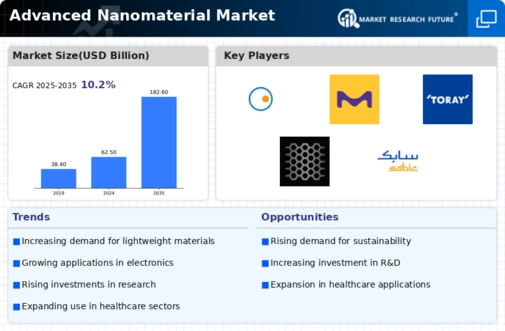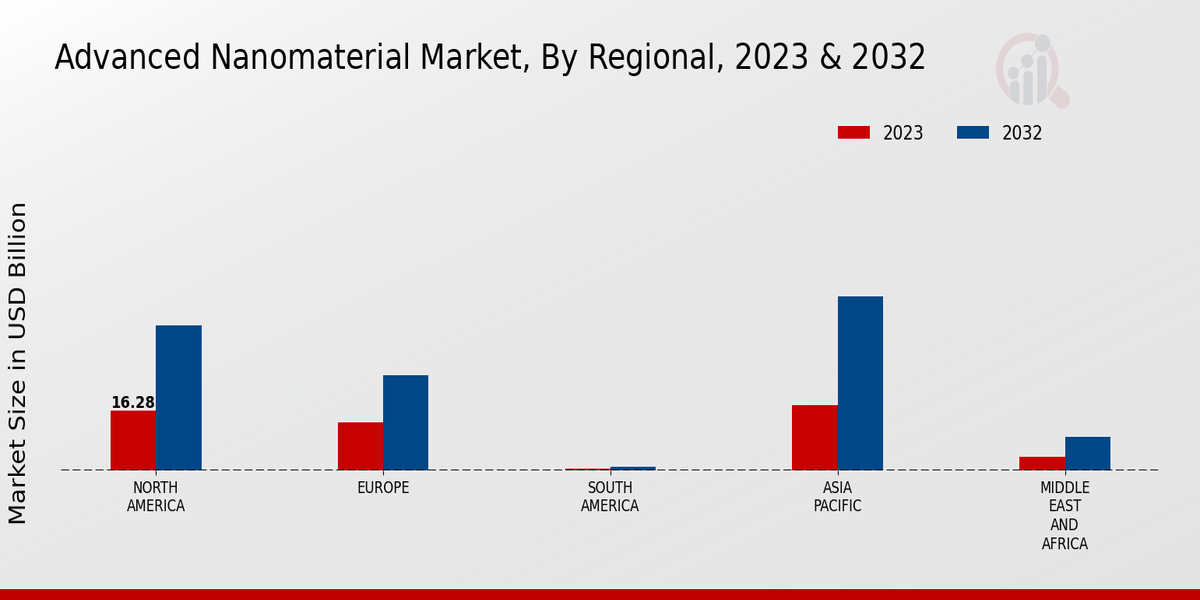Market Growth Projections
The Global Advanced Nanomaterial Market Industry is poised for substantial growth, with projections indicating a rise from 62.5 USD Billion in 2024 to 182.6 USD Billion by 2035. This growth trajectory suggests a compound annual growth rate (CAGR) of 10.24% from 2025 to 2035, reflecting the increasing adoption of nanomaterials across various industries. The anticipated expansion is driven by factors such as technological advancements, rising demand for energy-efficient solutions, and growing applications in healthcare and environmental sustainability. These projections underscore the industry's potential and the transformative impact of nanomaterials on global markets.
Growing Applications in Healthcare
The Global Advanced Nanomaterial Market Industry is increasingly finding applications in the healthcare sector, particularly in drug delivery and diagnostics. Nanomaterials, such as nanoparticles and nanocarriers, facilitate targeted drug delivery, improving therapeutic efficacy while minimizing side effects. For instance, gold nanoparticles are being utilized in imaging and as drug delivery agents, enhancing the precision of treatments. This trend is expected to drive market growth as healthcare providers seek innovative solutions to improve patient outcomes. The industry's expansion into healthcare is likely to contribute to its projected growth to 182.6 USD Billion by 2035, reflecting the increasing reliance on advanced materials in medical applications.
Advancements in Nanotechnology Research
Ongoing advancements in nanotechnology research are propelling the Global Advanced Nanomaterial Market Industry forward. Innovations in synthesis techniques and characterization methods are enabling the development of novel nanomaterials with tailored properties. For example, the emergence of graphene and carbon nanotubes has opened new avenues in electronics, energy storage, and biomedical applications. These advancements not only enhance the functionality of existing products but also pave the way for entirely new applications. As research continues to evolve, the market is anticipated to grow at a CAGR of 10.24% from 2025 to 2035, indicating a robust future driven by scientific progress.
Environmental Sustainability Initiatives
Environmental sustainability initiatives are significantly influencing the Global Advanced Nanomaterial Market Industry. Governments and organizations worldwide are promoting the use of nanomaterials in various applications to reduce environmental impact. For example, nanomaterials are being utilized in water purification systems, enabling more efficient removal of contaminants. Additionally, the development of biodegradable nanocomposites is gaining traction in packaging industries, aligning with global sustainability goals. These initiatives not only foster innovation but also create a favorable regulatory environment for the adoption of advanced nanomaterials, thereby enhancing market growth prospects.
Rising Demand for Energy-Efficient Solutions
The Global Advanced Nanomaterial Market Industry is witnessing a surge in demand for energy-efficient solutions across various sectors, including electronics and construction. As industries strive to reduce their carbon footprints, nanomaterials, known for their superior thermal and electrical properties, are increasingly being integrated into products. For instance, nanostructured coatings enhance the energy efficiency of buildings by minimizing heat loss. This trend is projected to contribute significantly to the market's growth, with the industry expected to reach 62.5 USD Billion in 2024, reflecting a growing awareness of sustainability and energy conservation.
Increasing Investment in Nanotechnology Startups
Investment in nanotechnology startups is a driving force behind the Global Advanced Nanomaterial Market Industry. Venture capital and government funding are increasingly directed towards innovative companies developing cutting-edge nanomaterials. This influx of capital supports research and development efforts, leading to the commercialization of novel products. For instance, startups focusing on sustainable nanomaterials are gaining attention as industries seek eco-friendly alternatives. The growing interest in nanotechnology investments is likely to accelerate market growth, fostering a dynamic ecosystem that encourages innovation and collaboration across sectors.
















